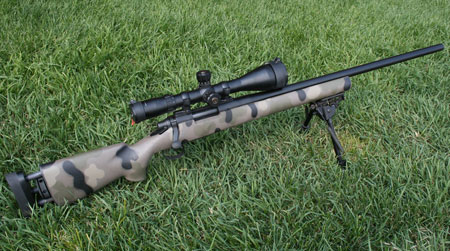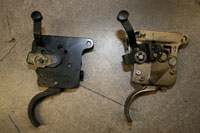

A nice, tight action will make your precision rifle shoot like a dream. Retired SWAT sniper and gunsmith Dave Morelli explains how.
The heart of any precision rifle is the action. It is made up of receiver, bolt, firing pin, trigger, recoil lug, and magazine.
The more precisely the action is assembled, the better the rifle will perform. Although there is a great deal of interest in the semi-auto precision rifle, I will cover the bolt-action here. I have tested many of the semi-auto sniping systems available and found them to be very accurate and more than adequate, but the bolt-action is still the preferred choice for the precision rifle.
The action can also be narrowed down from here to American-made or European. Again, I will restrict this information to the popular American-made actions although there are many high quality European choices available. I think the most popular American action is by far the Remington 700. It is one of my favorites because its design makes it more lathe friendly to machine. Many of the precision rifle manufacturers base their products on this action and Remington has a fine line of precision rifles ready to scope and use. Robar, McMillan, AWC, and H.S. Precision, produce some excellent precision rifles machined to extremely tight tolerances for incredible accuracy.
Winchester also is well known for producing a great action. The legendary pre-64 action with the large-claw extractor would be too much of a collector’s piece to rebuild into a precision rifle but post-64 models or one of the new large-claw extractor models would make a great action on which to base a rifle. Even though Carlos Hathcock confirmed 93 kills with the Winchester Action, Winchester doesn’t market a sniper rifle. I wouldn’t rule it out though.
I had an old Winchester rifle I bought new in the early 1980s that wouldn’t have much of a stock left if I notched it for every coyote it ironed out. I set the barrel back once to improve failing accuracy and just recently noticed the groups widening again. It was a featherweight model in 22-250 and I thought it would make a fine light hunting gun for medium-sized game if it was re-chambered and barreled to .308 Win. While it was apart, I ran it through the lathe and worked the action. I am still in the breaking-in period and it is giving ½-minute groups.

Savage has been coming up in the ranks developing their 110 action into a well-established tactical rifle. They are accurate rifles and their Accu-Trigger is a fine addition to any rifle. The trigger is another part of the action with a direct impact on accuracy. If the trigger doesn’t allow the operator to smoothly send the shot with the least amount of rifle movement, the bullet will not fly true. One of the biggest problems with standard factory rifle triggers is too much creep and excessive pull weight. The Accu-Trigger is crisp and adds a measure of safety in its design.
Mauser and Ruger actions are also excellent choices for a precision rifle. (I know, Mauser is a European action, but there are tons of them out there and they are still an excellent choice.) They are tried and true actions and the large claw extractor is all but indestructible and would be one less thing to fail. Starting with a military surplus Mauser to build your precision rifle on would be an inexpensive way to get an action. As always, Brownells carries a good supply of Mauser stuff to complete this project.
The bolt of the rifle contains the firing pin and extractor with some sort of ejector device. The ejector can be as simple as the bolt stop extending through to contact the base of the case to direct it out or a spring-loaded device in the bolt face to pop the case against the extractor to throw it clear. The Remington and Winchester bolts use this method. The only drawback is they can get dirty and stick, but I have never had a problem as long as I performed normal maintenance.
The Remington extractor is a tiny little piece of metal that looks like it would fail. Don’t let it fool you. It is really a trouble-free part considering it is tiny compared to the robust claw extractor of the Mauser and pre-64 style Winchesters. If it bothers you, it is a small modification to fit the bolt with a robust Sako-style extractor from Brownells. But adding it requires machining a slot in the bolt. The post-64 Winchesters have an extractor set in the front of the bolt and I have had no failures with it on the Featherweight noted above.
The bolt also houses the firing pin. This is one of the most ignored areas for cleaning on a bolt rifle. I think it is because every model has a little trick to taking it apart and there is the fear of sending parts into orbit. Learn how to disassemble your firing pin and keep it clean. Also, the locking lugs are very important; more specifically the contact surfaces that lock the bolt closed. A factory rifle can always stand some improvement here and if a new bolt is being used it should be fitted and lapped properly. The bolt face should also be as flat and perpendicular to the bore as possible.
What makes the precision rifle action different than mass-produced factory rifles? Usually only a couple thousandths of an inch. If you were to take a brand new hunting rifle out of the box and take it down you most likely will find that the bolt face, locking lugs, and face of the action to be out of square with the axis of the action by a few thousandths. These rifles will shoot one-minute groups, sometimes better, and are plenty accurate for most purposes. To consistently achieve the ½ MOA the professional or competitor is looking for this plane needs to be more precise and the locking lugs need to have as close to 100 percent engagement as possible when they contact on closing.
These tolerances are what we pay for when buying a precision rifle from the factory or when we have a gunsmith machine them out on a lathe and hand lap the lugs. Usually, the more of this work that is done by a master gunsmith, the tighter the rifle will be, and the more it will cost. Even though the precision-grade factory rifles are better, they are still produced in numbers and some of the individual TLC is missing. They will most likely shoot tighter than 70 percent of the marksman though.
Whether you start with a new action or resurrect an older rifle that has seen better days, the action is the heart of a precision rifle. So focus on the three most important parts: square and precise machining to provide solid bolt lock-up; a good trigger with very little creep and a magazine that will hold the rounds you expect to use. These factors will go a long way to improving the rifle’s overall performance.
Read Part 2
Read Part 3
Read Part 4

Next Step: Get your FREE Printable Target Pack
Enhance your shooting precision with our 62 MOA Targets, perfect for rifles and handguns. Crafted in collaboration with Storm Tactical for accuracy and versatility.
Subscribe to the Gun Digest email newsletter and get your downloadable target pack sent straight to your inbox. Stay updated with the latest firearms info in the industry.

![Best Concealed Carry Guns In 2025 [Field Tested] Wilson Combat EDC X9S 1](https://gundigest.com/wp-content/uploads/Wilson-Combat-EDC-X9S-1-324x160.jpg)


![Best 9mm Carbine: Affordable PCCs [Tested] Ruger Carbine Shooting](https://gundigest.com/wp-content/uploads/Ruger-Carbine-Shooting-100x70.jpg)
![Best AR-15: Top Options Available Today [Field Tested] Harrington and Richardson PSA XM177E2 feature](https://gundigest.com/wp-content/uploads/Harrington-and-Richardson-PSA-XM177E2-feature-100x70.jpg)
